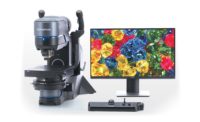First, let’s look at overall combined benefits. When all components are fully motorized, calibration through your imaging software is seamless. Your software will align the focus point or drift between objectives, allowing the image to stay in focus when changing magnification. The software will also align any XY shift between objectives. This will keep a point of interest that’s in the center of the field of view to remain in the center even when switching between objectives. Your software will physically move the XY location. Your imaging software will also set values to peak performance depending on the imaging method and/or objective lens selection.
Full motorization also results in an overall increase in throughput due to the automation of many imaging techniques and reduced operator skill requirements as the system can be set up through software, allowing for a simplified interface and use. This will also improve repeatability of images and measurements between operators at varying skill levels. Within the software user access rights can be set so operators who need an engineering-level interface can have and access these functions, while basic operators are set to use a simplified interface.
Additional functions and benefits that come with a fully motorized system include enhanced microscope control and communication, including better control of microscope functions such as observation method (BF, DF, DIC), objective lens selection, lighting conditions, and aperture control. Made possible through software or hand switches, this enhanced control provides a number of benefits to the operator including:
Guaranteed calibration as the software will have feedback to which objective lens is in place when the image is captured
Simplified microscope configuration setup through observation method selection in software. This allows for all microscope functions to be automatically set for predefined observation conditions. Example: DF condition would set the DF mirror turret, turn the lamp intensity to max, open the aperture stop to max, change to the DF objective lens, and possibly even set a focus point.
The ability to read and load microscope values from captured images within imaging software. This allows you to set up the system in the exact same configuration as when the image was taken.
An increase in ergonomics as operators no longer have to reach up to the microscope to make changes to magnification or image methods
An increase in sample cleanliness as users no longer need to reach above the sample to make changes to objective lenses or observation methods
A fully motorized microscope configuration may look like this:
Fully motorized microscope frame
Motorized XY stage (i.e., Prior, LUDL, Marzhauser)
Motorized Z (focus)
Motorized add-on Focus drive (if not already included on microscope frame)
Stage controller (either an external control box or internal PC card)
Joystick for XY control and possibly Focus control
Digital camera for automated
image acquisition
Control software
A motorized XY stage provides the following user benefits:
Ability to perform MIA (Multiple Image Alignment). Allows for large out-of-field-of-view image capture through stitching.
Ability to set and save location points for return inspection.
This is used a lot for inspection points on wafers, semiconductor dies, or circuits.
Motorized control is very ergonomic as the user can move the joystick to any location, or control all stage movement and values through software. You no longer have to reach under or next to the stage to move the sample.
A motorized Z (focus) delivers the following operational enhancements:
Ability to perform EFI (Extended Focal Imaging). This allows you to capture multiple Z focus images to generate an all-in-focus image. Ideal for samples with great depths or heights.
Focus maps. When stitching in XY, this added ability will compensate for any sample drift in focus, allowing you to stitch large areas while having your software keep the sample in focus.
Improved ergonomics as the focus is now motorized, keeping you from having to reach for focus knobs. This is done either with software control or joystick.
Added measurement and analytical tools with a fully motorized microscope system:
Large area stitching allows for measurement of features too large to see in a single field of view.
Extended focal imaging creating an all in focus image allows for 3D imaging and Z height or depth measurements.
Automated measurements such as filter or particle inspection for greater throughput of cleanliness inspection processes.
An automated geometric measurement at multiple point locations improves measurement speed and removes the human element from the measurement process, thus improving repeatability of measurements.
Motorized Nosepieces
As part of a fully motorized microscope system, motorized nosepieces can provide increased inspection speed. The rotational speed of motorized nosepieces is faster and safer than manual nosepieces, decreasing time between inspections while maintaining cleanroom compatibility. In most cases, motorized nosepieces are controlled via software, a frame button, or an independent handset.
Handset for Tactile Control
Within a motorized microscope environment, an ergonomically designed handset can allow pushbutton control of the motorized functions of the microscope such as the selection of the objective lens and observation technique. The operator can also use this handset to switch between varying autofocus controls, manually fine-focus, adjust the retardation position in DIC, control lamp intensity, and lower the stage for sample exchange.
Active Laser Autofocus
A motorized microscope system may be equipped with an active laser autofocus unit designed to improve the accuracy and speed of inspections. A multi-spot sensor enables a substantial increase in stability by eliminating the effects of vertical topography on the sample, providing even faster and more predictable results.
Automatic Aperture Control
Within a motorized microscope, a motorized aperture stop can be interlocked with the objective lens, automatically adjusting for the objective lens in use. Image quality for every magnification is thus optimized, making routine inspections more comfortable for the eyes and more efficient for the operator.
Advanced Imaging Software Integration
In combination with motorized scanning stages, advanced imaging software can be integrated into a motorized microscope system to enable the operator to easily stitch various images beyond a single view, furthering image acquisition and analysis possibilities. Imaging software also allows intuitive control of the motorized stage and provides a workflow-oriented interface for complex image analysis. At the click of a button, image analysis tasks can be executed quickly and precisely. By significantly reducing processing time for repeated tasks, operators can concentrate more fully on the inspection at hand.
A fully motorized microscope system can provide users with a wide range of performance improvements including an enhanced and easier workflow. Image focus and centricity can be improved for ease of image viewing. Consistency of images between users can be guaranteed by automating imaging techniques or loading predetermined values.
A motorized microscope increases analysis capabilities through image stitching, and automated point inspection allows for greater flexibility. Cleanliness and ergonomics are also greatly improved with little to no manual manipulation of microscope components needed. Stepping up to a fully motorized digital microscope system will add all of these benefits and more to your work processes and results.












